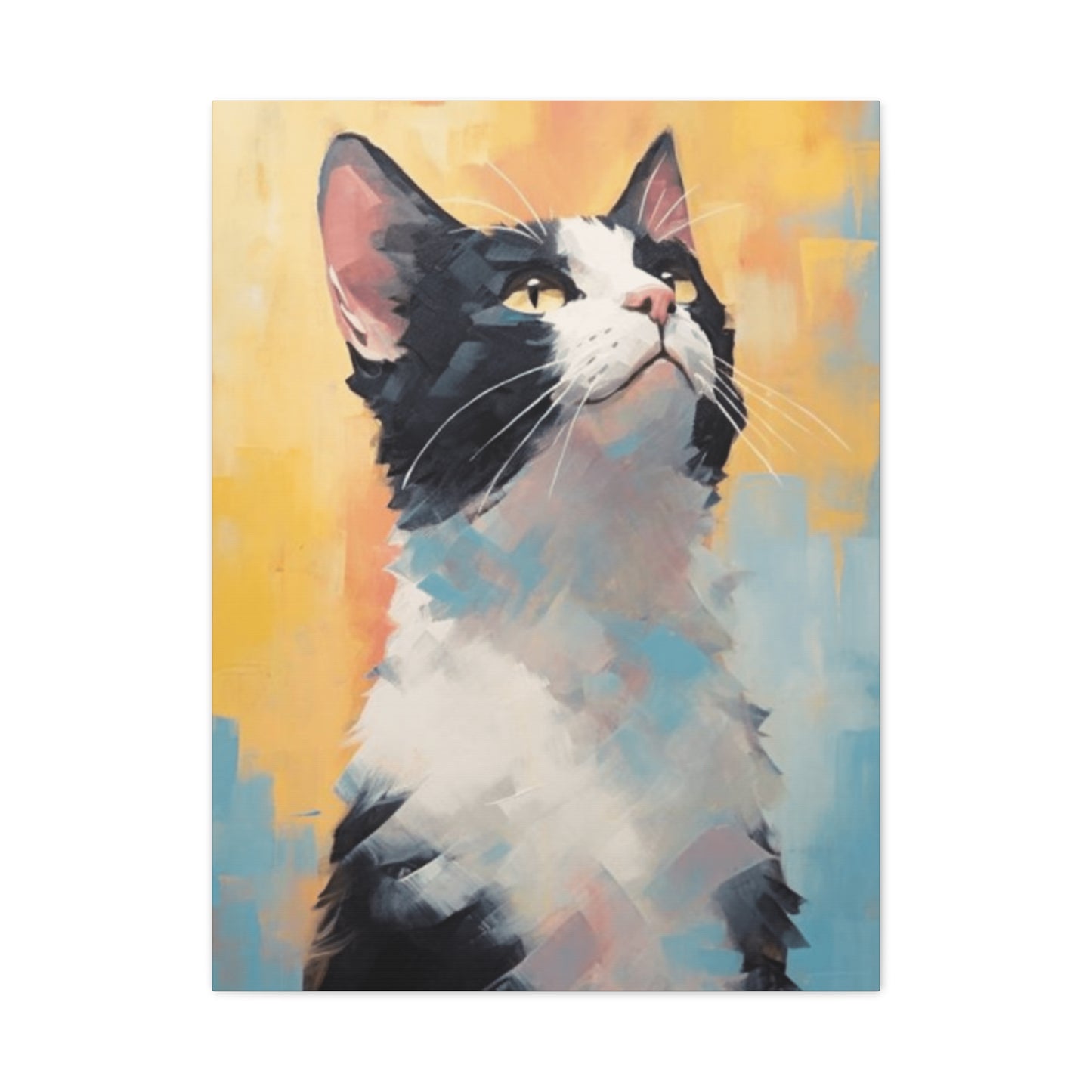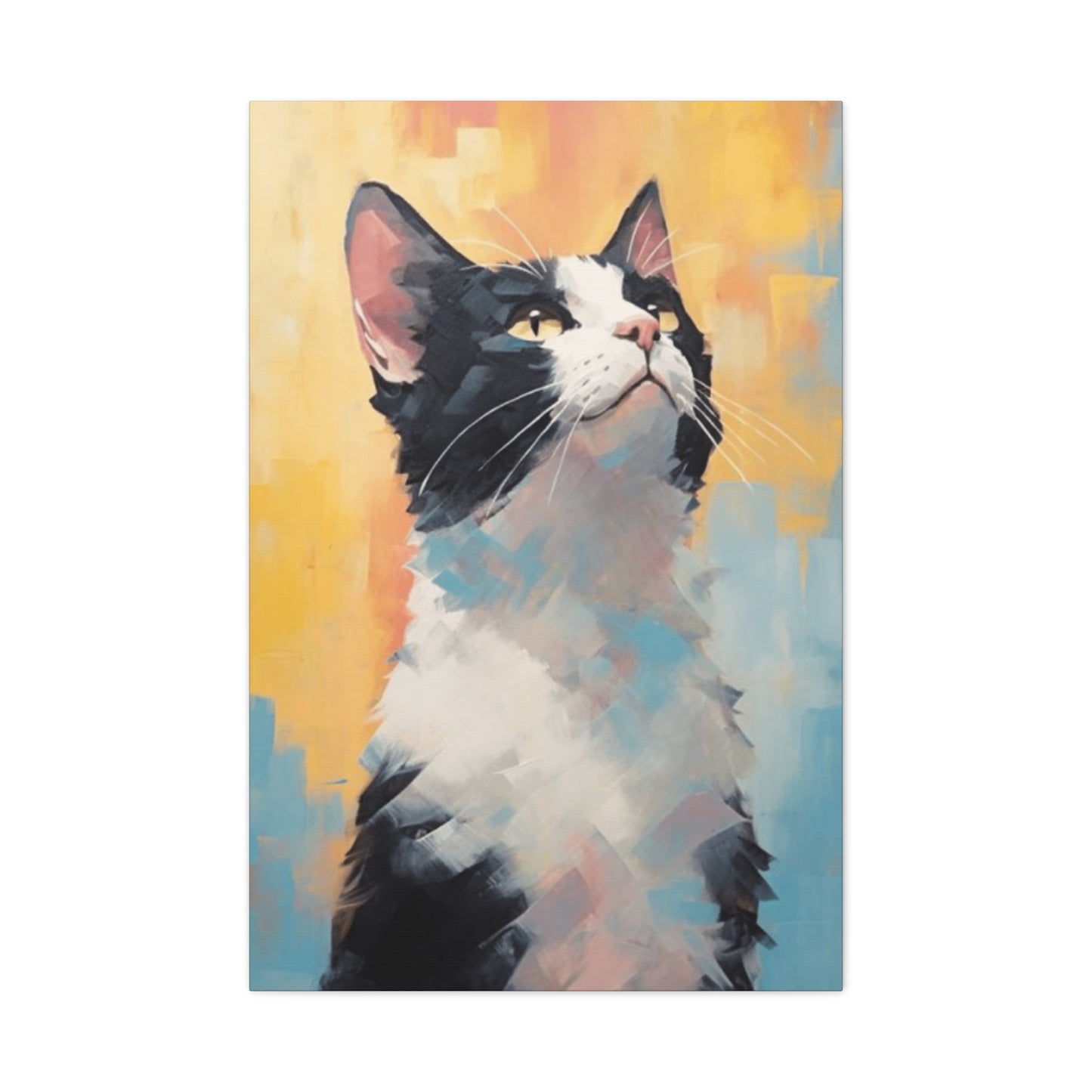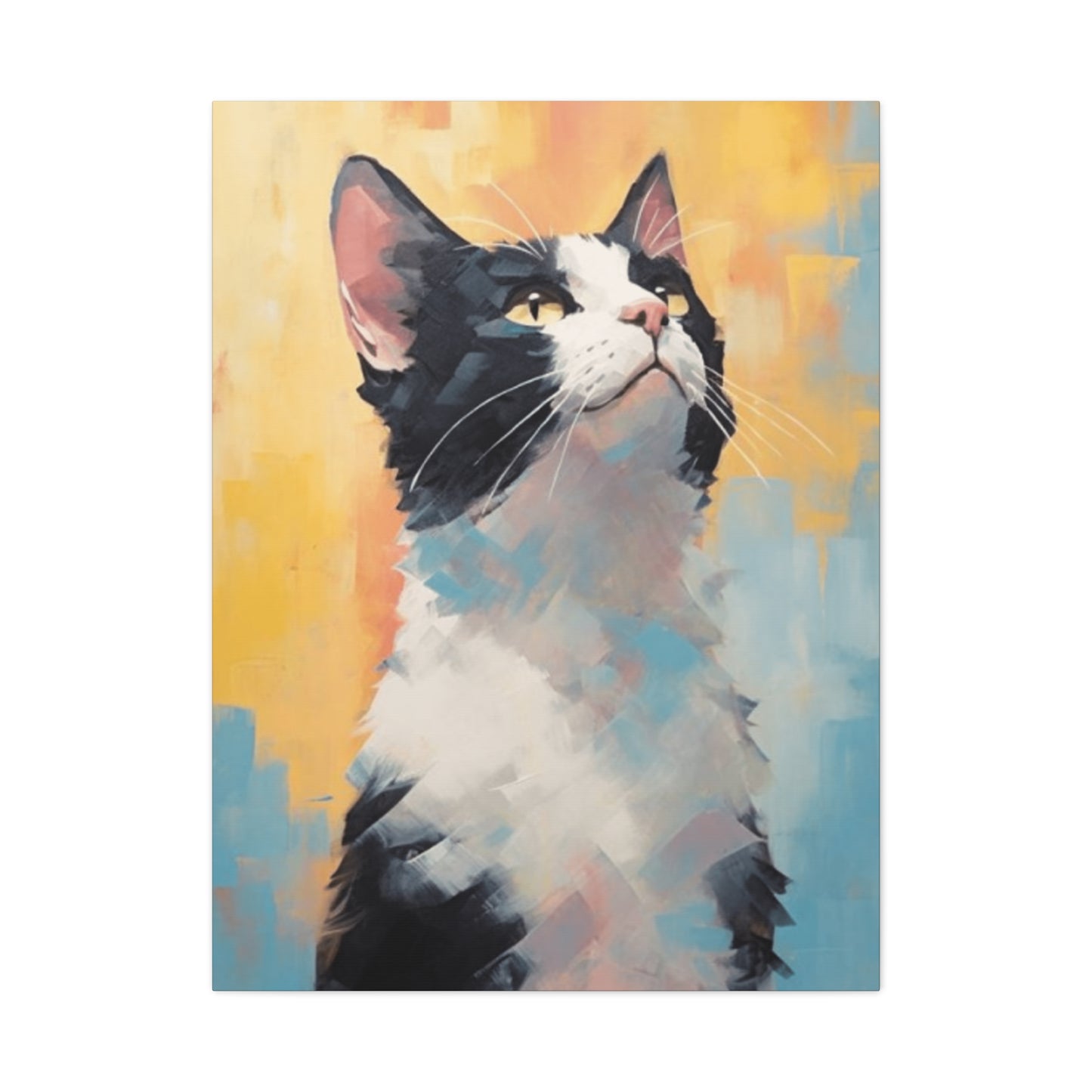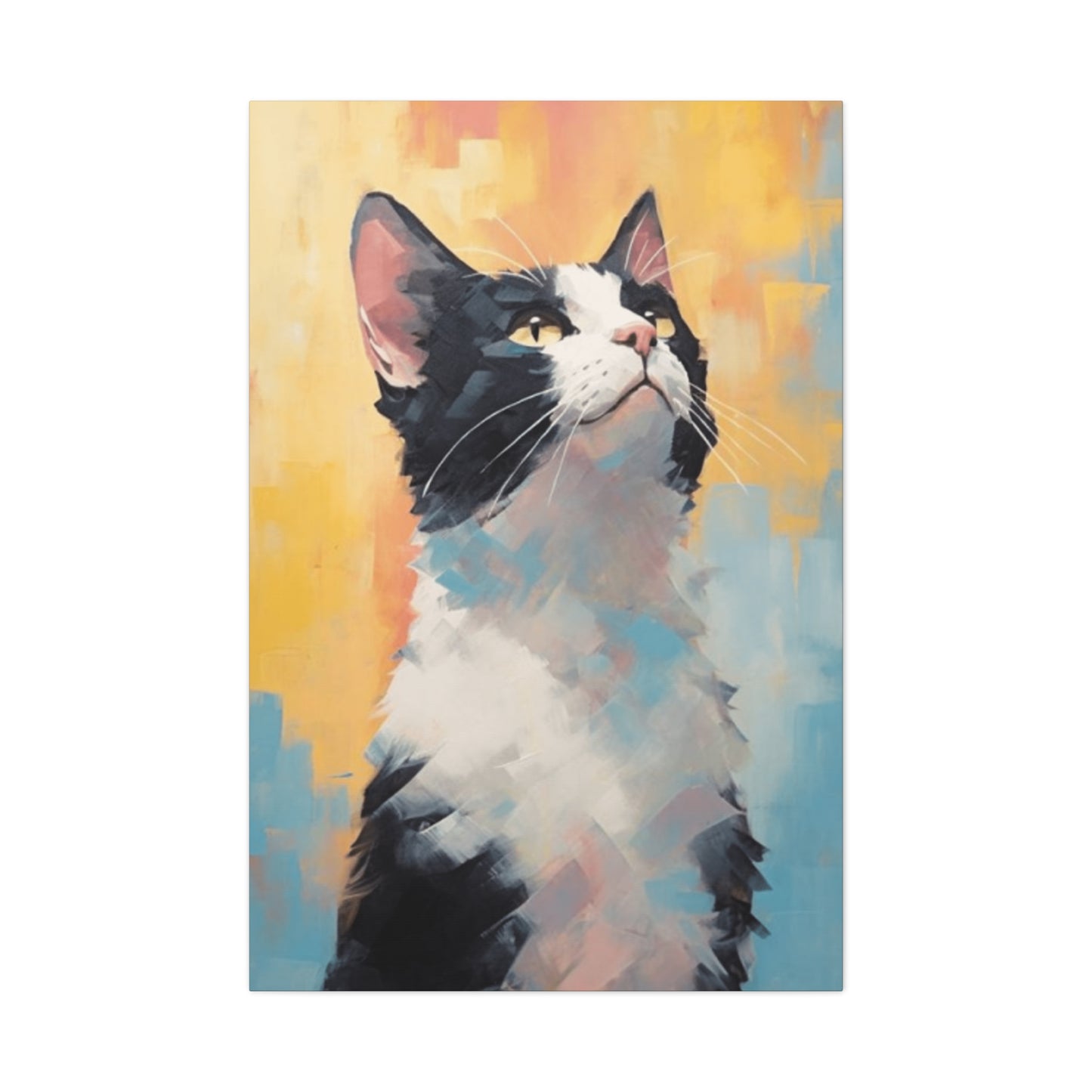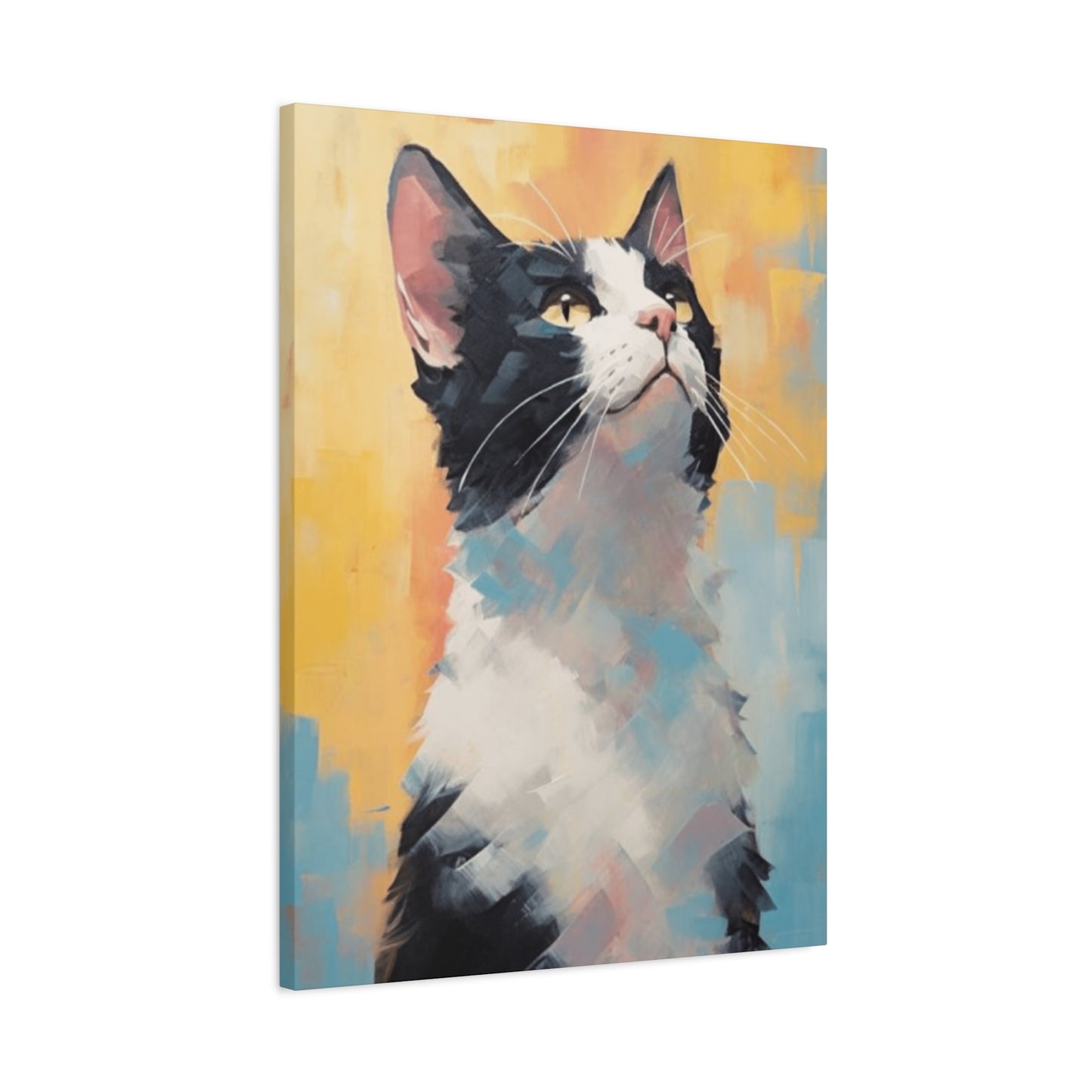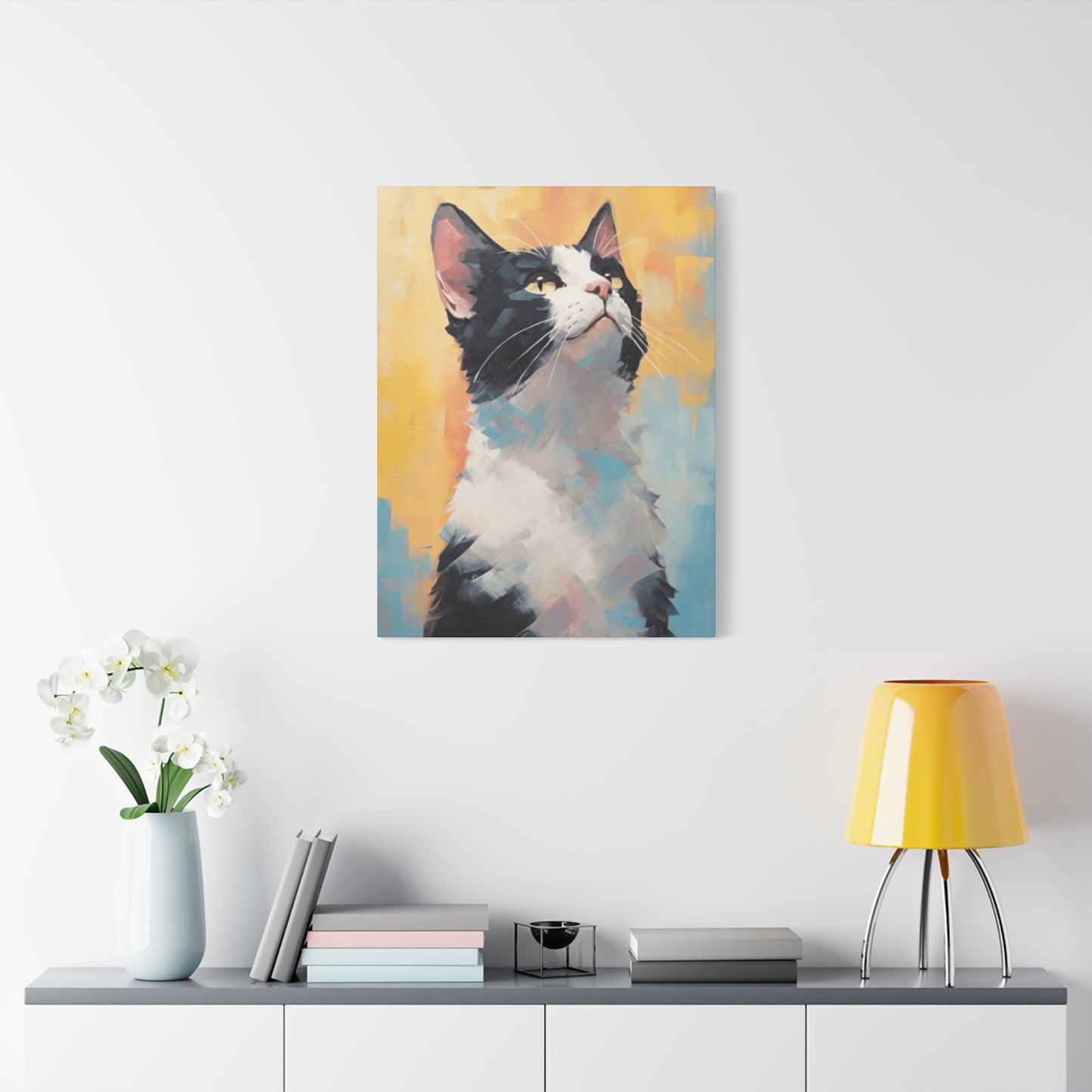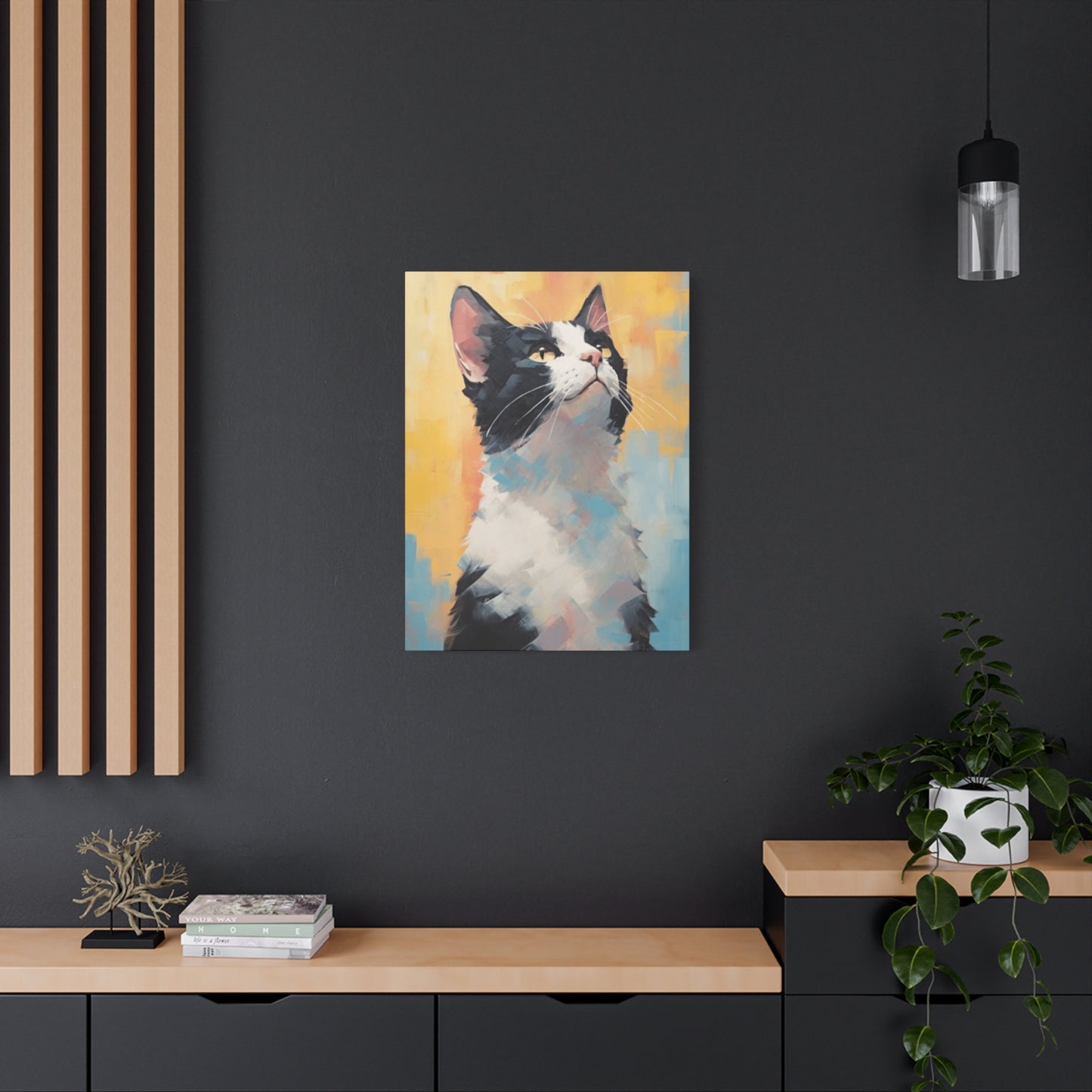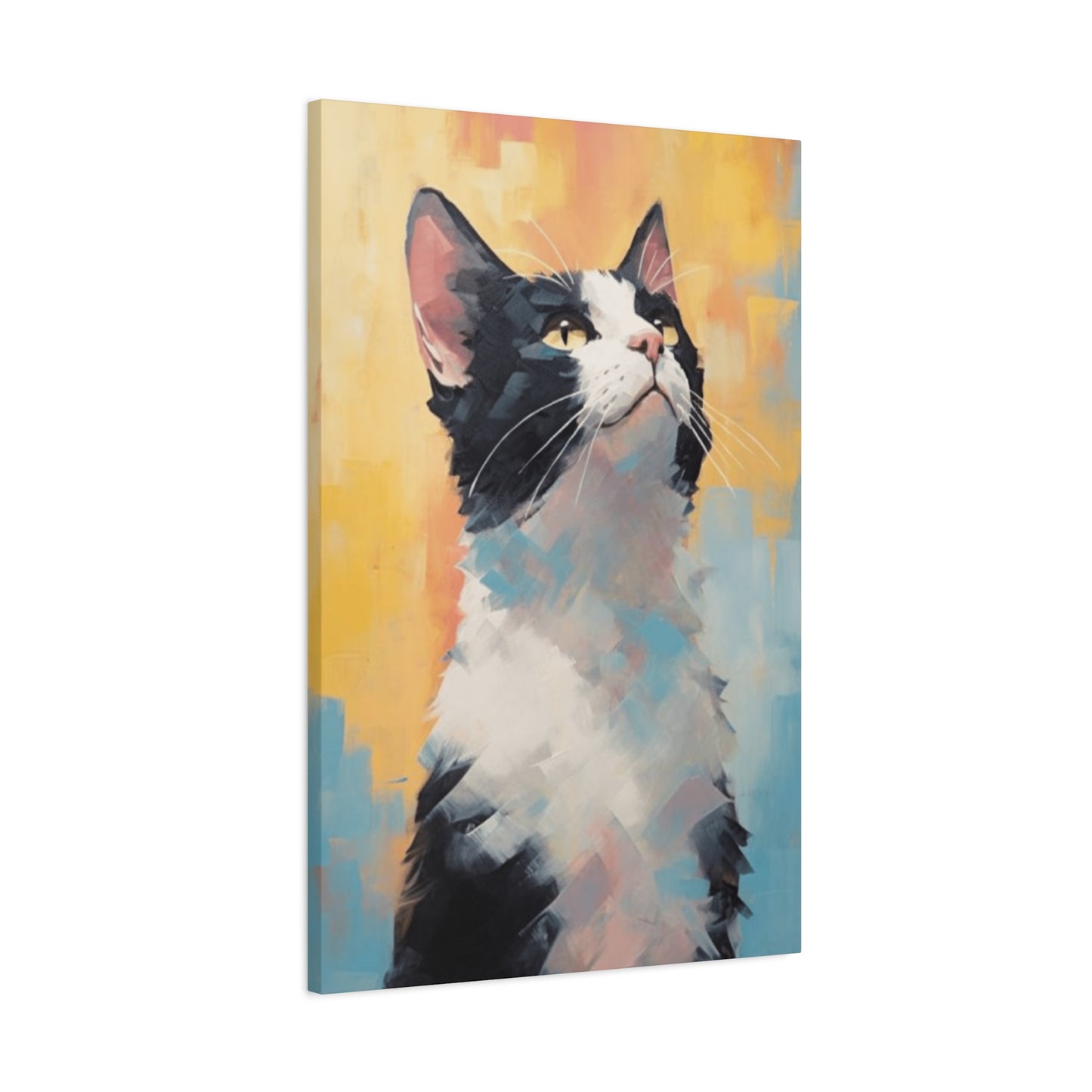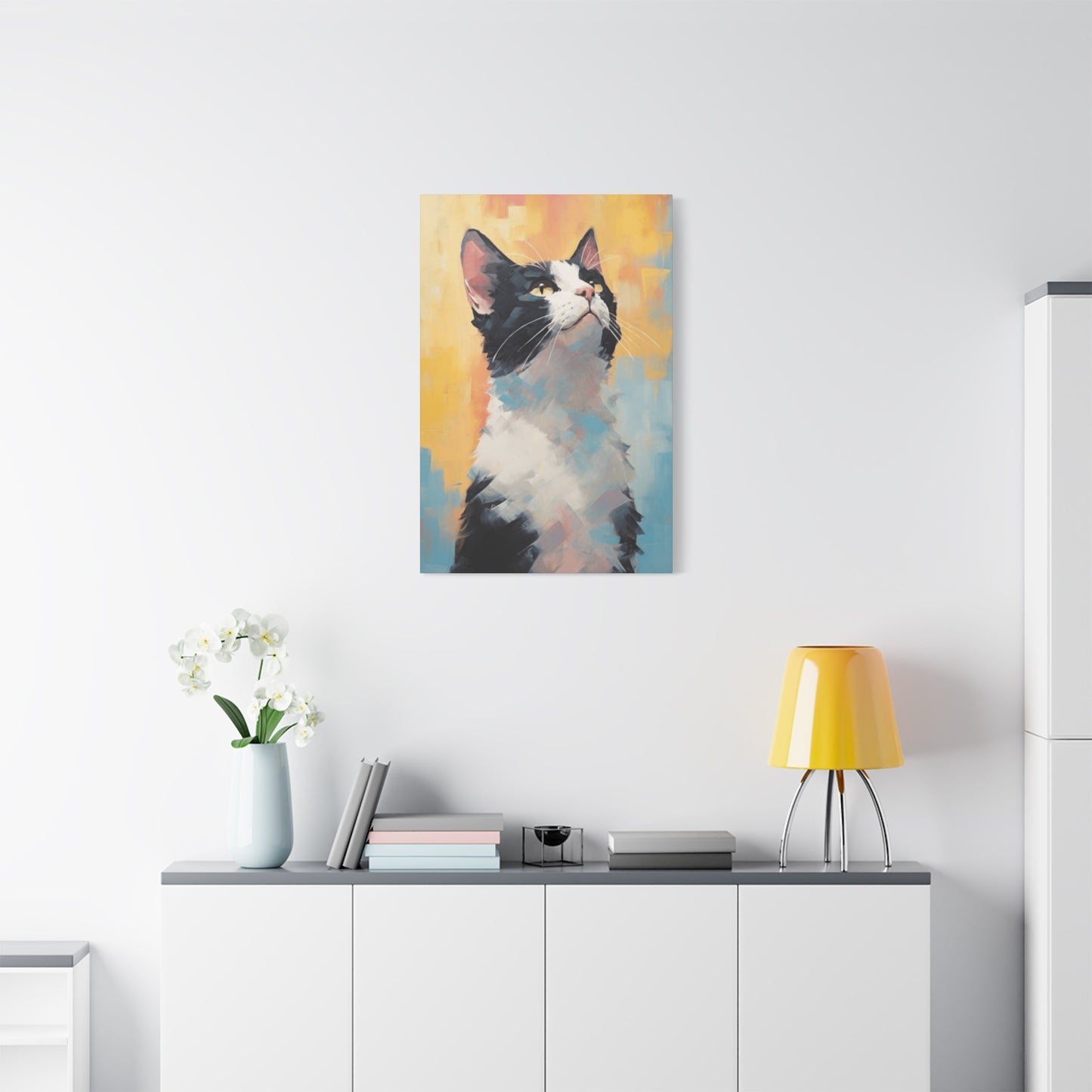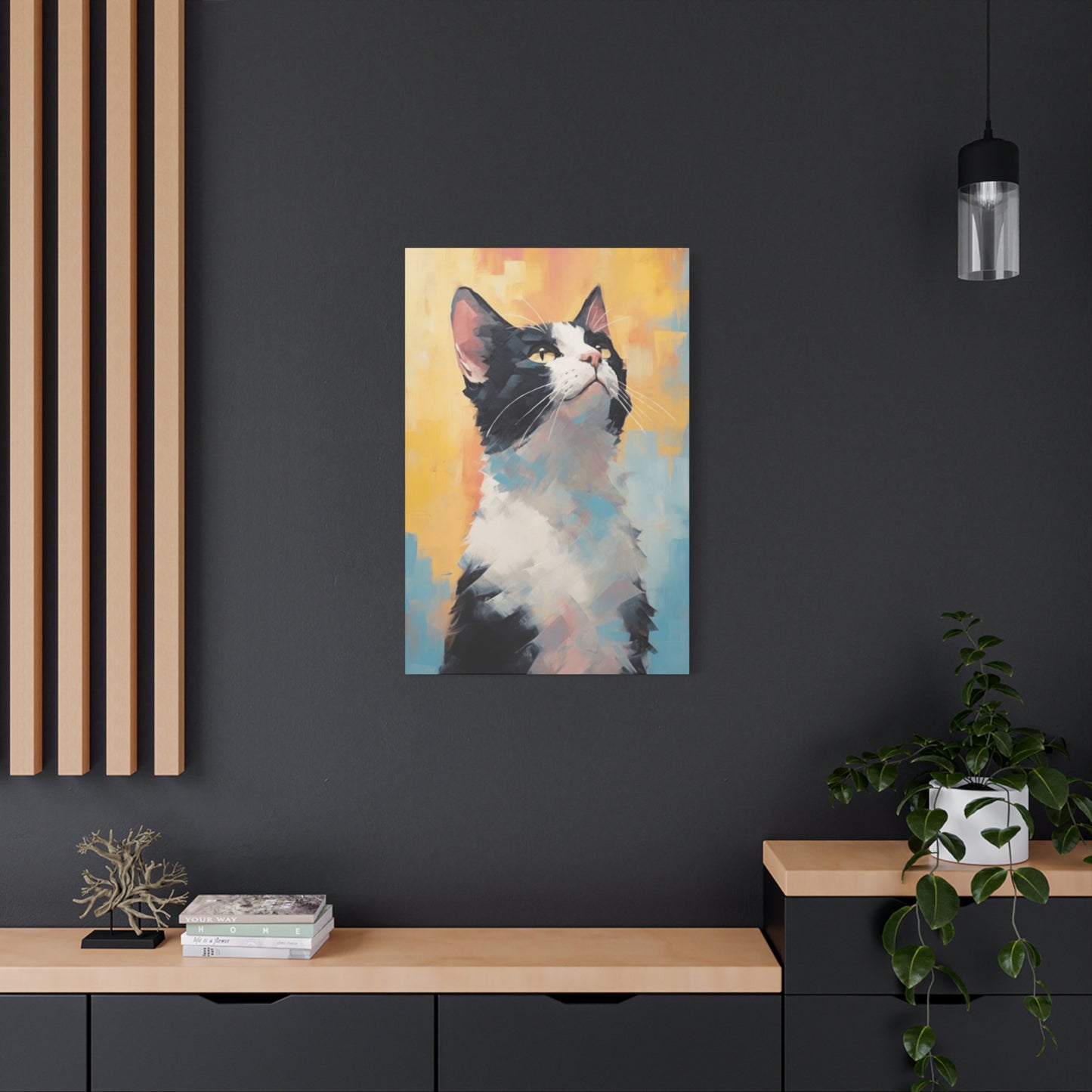Abstract Feline Portrait Wall Art: Stylish Wall Decor for Cat Lovers
The presentation of cat portraits on canvas requires careful consideration of both artistic merit and environmental factors. Proper display techniques can dramatically enhance the visual impact of these beloved pieces while ensuring their longevity and aesthetic appeal within your living space.
Lighting plays a crucial role in how your feline artwork appears throughout different times of the day. Natural light can bring out the vibrant colors and intricate details in abstract cat portraits, but direct sunlight should be avoided to prevent fading and damage to the canvas material. Consider positioning your cat artwork where it receives indirect natural light during peak daylight hours, while supplementing with adjustable artificial lighting for evening viewing.
The height at which you hang your cat portraits significantly affects their visual impact and accessibility. Generally, the center of your artwork should be positioned at eye level, approximately 57-60 inches from the floor. However, this measurement may need adjustment based on the viewing angle of your furniture arrangement and the specific dimensions of your cat portrait pieces.
Frame selection can either complement or compete with your feline artwork. For abstract cat portraits with bold colors and dynamic compositions, consider simpler frame designs that won't distract from the artistic content. Conversely, more subdued or monochromatic cat artworks might benefit from frames with interesting textures or decorative elements that add visual interest without overwhelming the piece.
Grouping multiple cat portraits together creates opportunities for storytelling and visual rhythm within your space. Consider varying the sizes of your canvases while maintaining consistent themes, color palettes, or artistic styles. This approach allows you to create a cohesive gallery wall that celebrates your appreciation for feline artistry while adding depth and personality to your interior design.
The surrounding wall color significantly influences how your cat portraits are perceived and appreciated. Neutral backgrounds such as whites, grays, or soft beiges allow colorful abstract cat artwork to stand out prominently, while darker wall colors can create dramatic contrasts that make lighter-toned pieces appear more luminous and captivating.
Proper spacing between multiple pieces ensures each artwork receives adequate visual breathing room while contributing to the overall composition. A general rule suggests maintaining 2-3 inches between smaller pieces and 3-6 inches between larger artworks, though these measurements should be adjusted based on your specific room dimensions and viewing distances.
Abstract Feline Expression: Making Bold Interior Design Statements
Abstract feline artwork represents a sophisticated approach to incorporating animal themes into contemporary interior design. These pieces transcend traditional pet portraiture by focusing on emotional expression, color relationships, and artistic interpretation rather than photographic representation of cats.
The power of abstract cat art lies in its ability to capture the essence and spirit of felines through artistic interpretation. Artists working in this genre often emphasize the graceful curves of a cat's silhouette, the intensity of their gaze, or the fluid movement that characterizes feline behavior. These elements are then translated into bold brushstrokes, vibrant color palettes, and dynamic compositions that speak to viewers on an emotional level.
Color psychology plays a significant role in how abstract feline artwork affects the atmosphere of your living space. Warm colors such as oranges, reds, and yellows can create energetic and welcoming environments, while cooler tones like blues, purples, and greens tend to promote calm and contemplative moods. Abstract cat portraits that incorporate both warm and cool tones offer versatility in interior design applications.
The scale of abstract feline artwork should complement the proportions of your room and furniture arrangements. Large-scale pieces work effectively as focal points in spacious rooms with high ceilings, while smaller abstract cat portraits are perfect for intimate spaces or when creating curated gallery walls with multiple artworks.
Texture adds another dimension to abstract feline art that can enhance the tactile appeal of your interior space. Some artists incorporate impasto techniques, creating thick applications of paint that add physical dimension to the canvas surface. Others might use mixed media approaches, combining traditional painting with collage elements or other materials that create interesting textural contrasts.
The emotional resonance of abstract feline artwork often connects with viewers who appreciate both cats and artistic expression. These pieces can evoke memories of beloved pets while simultaneously serving as sophisticated design elements that demonstrate artistic appreciation and cultural awareness.
Contemporary abstract cat art often reflects current artistic movements and cultural trends, making these pieces conversation starters and indicators of contemporary taste. Collectors and interior design enthusiasts appreciate how these works bridge the gap between personal passion and artistic sophistication.
Selecting Appropriate Feline Artwork for Your Living Environment
The process of choosing cat artwork for your space requires careful consideration of multiple factors including room function, existing decor, personal preferences, and long-term design goals. This decision-making process becomes particularly important when selecting pieces that will serve as focal points or contribute to the overall aesthetic narrative of your home.
Room functionality significantly influences artwork selection decisions. Living rooms and family spaces often benefit from more dynamic and colorful cat artwork that encourages conversation and creates welcoming atmospheres. Bedrooms might call for more serene and contemplative feline pieces that promote relaxation and peaceful moods. Office spaces could accommodate bold abstract cat portraits that inspire creativity and reflect personal interests.
Your existing color scheme provides important parameters for artwork selection. Cat portraits with complementary colors will harmonize naturally with your current decor, while pieces with contrasting colors can serve as dramatic accent pieces that energize the space. Consider how the artwork will appear under both natural and artificial lighting conditions throughout different seasons and times of day.
The architectural features of your space influence both the size and style of cat artwork that will work effectively. Rooms with clean, modern lines might benefit from contemporary abstract feline pieces, while spaces with traditional architectural elements could accommodate more classic approaches to cat portraiture. High ceilings can support larger artworks, while lower ceilings might require more modest sizing to maintain proper proportional relationships.
Your personal connection to cats and feline imagery should guide your selection process. Whether you're a cat owner, admirer, or simply appreciate the artistic possibilities of feline subjects, your emotional response to different pieces will influence how much you enjoy living with the artwork over time. Consider how different artistic interpretations of cats resonate with your personal experiences and aesthetic preferences.
Budget considerations affect both the quality and quantity of cat artwork you can acquire. Original paintings typically command higher prices than prints, but high-quality reproductions can provide excellent value while still delivering significant visual impact. Consider building your collection gradually, starting with key pieces that will anchor your design scheme and adding complementary works over time.
The longevity of your design choices becomes important when investing in artwork that you intend to live with for years. While trendy pieces might provide immediate satisfaction, selecting cat artwork with timeless artistic merit ensures continued appreciation and compatibility with evolving interior design preferences.
Versatile Feline Art: From Playful to Sophisticated Design Applications
The versatility of cat-themed artwork allows for integration into virtually any interior design style, from whimsical children's spaces to sophisticated contemporary environments. This adaptability stems from the diverse artistic approaches available and the universal appeal of feline subjects across different cultural and aesthetic contexts.
Whimsical applications of cat artwork often emphasize playful colors, simplified forms, and lighthearted interpretations of feline behavior. These pieces work particularly well in casual family spaces, children's rooms, or anywhere you want to inject a sense of joy and spontaneity into the environment. Bright primary colors, cartoon-like styling, and humorous compositions characterize this approach to feline art.
Sophisticated applications focus on artistic merit, refined color palettes, and complex compositional structures that demonstrate serious artistic consideration. These pieces often feature subtle color relationships, expert brushwork, and thoughtful exploration of light, shadow, and form. Such artworks function effectively in formal living spaces, professional environments, or anywhere you want to project cultural refinement and artistic awareness.
Contemporary design styles embrace clean lines, minimal ornamentation, and focus on essential elements. Cat artwork suitable for contemporary interiors typically features simplified forms, monochromatic or limited color palettes, and emphasis on shape and composition rather than decorative detail. These pieces complement modern furniture and architectural elements while adding organic interest to potentially sterile environments.
Traditional design approaches appreciate classical artistic techniques, rich colors, and detailed rendering. Cat portraits suitable for traditional interiors might feature realistic rendering techniques, warm color palettes, and compositional approaches that reference classical art historical precedents. These pieces harmonize with traditional furniture styles and architectural details.
Eclectic interior design celebrates the combination of different styles, periods, and cultural influences. Cat artwork for eclectic spaces can range widely in style, size, and artistic approach, with the unifying factor being the homeowner's personal taste and the overall compositional balance of the room. This approach allows for creative combinations that might not work in more stylistically uniform environments.
Minimalist design philosophy emphasizes the elimination of unnecessary elements and focus on essential components. Cat artwork appropriate for minimalist interiors typically features clean compositions, limited color palettes, and emphasis on negative space and essential forms. These pieces should enhance rather than complicate the overall design aesthetic.
Contemporary Trends in Abstract Animal Portrait Artistry
The field of abstract animal portraiture has experienced significant evolution in recent years, with artists exploring new techniques, materials, and conceptual approaches to representing beloved creatures like cats. These developments reflect broader trends in contemporary art while addressing the growing market for pet-related artistic expression.
Digital art technologies have expanded the possibilities for abstract animal portraiture, allowing artists to experiment with effects and compositions that would be difficult or impossible to achieve through traditional media. These digital works can be reproduced as high-quality prints on canvas, making sophisticated abstract cat art more accessible to wider audiences while maintaining excellent visual quality.
Mixed media approaches combine traditional painting techniques with collage, photography, textural elements, and other materials to create complex layered compositions. Abstract cat portraits using mixed media can incorporate actual cat fur, vintage photographs, text elements, or other materials that add conceptual depth and tactile interest to the finished artwork.
Large-scale abstract animal portraits have gained popularity as statement pieces for contemporary interiors. These oversized artworks command attention and can transform the character of entire rooms. The trend toward larger living spaces and open floor plans has created opportunities for artwork that might have seemed overwhelming in more traditional home layouts.
Environmental consciousness has influenced some artists to explore sustainable materials and practices in their abstract animal artwork. This might include using recycled materials, non-toxic paints, or sustainable canvas materials. These considerations appeal to environmentally aware consumers who want their art purchases to align with their values.
Cultural fusion approaches blend artistic traditions from different cultures to create unique interpretations of animal subjects. Abstract cat portraits might incorporate elements from Asian brush painting, African textile patterns, or indigenous art traditions, creating pieces that celebrate both feline subjects and cultural diversity.
Collaborative projects between artists and animal welfare organizations have resulted in abstract cat artwork that serves charitable purposes while providing artistic merit. These initiatives often feature auction events or percentage-based donations that connect art collectors with animal advocacy causes.
Integrating Cat-Themed Canvas Art into Home Decoration Schemes
The successful integration of cat-themed artwork into home decoration requires strategic planning and consideration of how these pieces will interact with existing design elements. This process involves balancing personal passion for feline subjects with broader aesthetic goals and practical considerations related to room function and traffic patterns.
Creating focal points with cat artwork involves positioning pieces where they will naturally draw attention and enhance the room's visual hierarchy. This might mean placing a large abstract cat portrait above a fireplace, sofa, or dining room buffet where it will be easily visible and can anchor the surrounding design elements. The key is ensuring that the artwork enhances rather than competes with other important design features.
Color coordination between cat artwork and existing design elements requires careful attention to both obvious and subtle color relationships. Direct color matching can create harmonious effects, while complementary color combinations can add energy and visual interest. Consider how artwork colors will appear under different lighting conditions and how they relate to both permanent elements like flooring and changeable elements like throw pillows or seasonal decorations.
Seasonal rotation of cat artwork allows you to refresh your living space while accommodating different moods and occasions throughout the year. Lighter, more colorful pieces might work well during spring and summer months, while richer, more contemplative works could be appropriate for fall and winter display. This approach requires adequate storage and handling procedures to protect artwork when not displayed.
Traffic flow considerations affect where cat artwork should be positioned within your home. High-traffic areas might require more durable framing and protective measures, while quieter spaces can accommodate more delicate pieces. Consider how artwork placement affects movement through your space and whether pieces might be accidentally bumped or damaged in certain locations.
Lighting design specifically tailored to highlight cat artwork can dramatically enhance the visual impact and appreciation of these pieces. Track lighting, picture lights, or strategically placed table lamps can provide focused illumination that brings out color and detail while creating dramatic effects during evening hours. Dimmer switches allow for lighting adjustments that can change the mood and appearance of artwork throughout different occasions.
Integration with furniture arrangements requires consideration of sight lines, proportional relationships, and functional requirements. Artwork positioned behind seating areas should be hung high enough to clear seated occupants while remaining visible from other vantage points. Console tables, bookchelves, and other furniture pieces can provide opportunities for displaying smaller cat artwork or supporting larger pieces.
Abstract Feline Art for Minimalist Interior Design Approaches
Minimalist interior design philosophy emphasizes the principle of "less is more," focusing on essential elements while eliminating unnecessary decoration and visual clutter. Abstract cat artwork suitable for minimalist environments must align with these principles while still providing meaningful artistic expression and emotional connection.
Compositional simplicity becomes crucial when selecting abstract feline art for minimalist spaces. Pieces that feature clean lines, geometric forms, and uncluttered compositions work most effectively within this design philosophy. The artwork should capture the essence of feline subjects through reduction rather than elaboration, focusing on fundamental shapes and relationships rather than decorative detail.
Limited color palettes align with minimalist principles by reducing visual complexity and promoting calm, focused environments. Abstract cat portraits using monochromatic schemes, neutral colors, or carefully selected accent colors integrate seamlessly with minimalist interior schemes. The emphasis should be on color quality and relationships rather than quantity or variety.
Negative space plays an important role in minimalist design and should be considered when selecting abstract feline artwork. Pieces that make thoughtful use of empty or unoccupied areas create breathing room and allow viewers to appreciate the essential elements without distraction. This approach can make small spaces feel larger and more open.
Scale considerations become particularly important in minimalist environments where each design element receives careful scrutiny. Abstract cat artwork should be appropriately sized for the space and viewing distance, avoiding pieces that are either too small to make an impact or too large to maintain the uncluttered aesthetic that minimalism requires.
Quality over quantity principles suggest that minimalist spaces benefit from fewer, higher-quality pieces rather than multiple artworks of lesser significance. Investing in one exceptional abstract cat portrait that truly resonates with your aesthetic preferences and design goals will be more effective than displaying multiple pieces of moderate quality or impact.
Functional integration considerations address how artwork serves multiple purposes within minimalist environments. Abstract cat portraits might function simultaneously as color accents, focal points, and expressions of personal interest while maintaining the clean, uncluttered appearance that minimalist design requires.
Material considerations affect how abstract feline artwork fits within minimalist interior schemes. Natural materials, clean finishes, and high-quality craftsmanship align with minimalist values while supporting the longevity and continued appreciation that these design approaches require.
Enhancing Personal Spaces with Feline-Inspired Wall Prints
Wall prints offer an accessible and flexible approach to incorporating feline-inspired artwork into personal living spaces. These reproductions of original artworks provide opportunities to enjoy sophisticated artistic content while accommodating various budget levels and design requirements.
Print quality significantly affects the visual impact and longevity of feline wall art. High-resolution digital prints on quality papers or canvas materials can closely approximate the appearance of original artwork while offering durability and fade resistance. Giclée printing processes using archival inks provide museum-quality results that will maintain their appearance for decades when properly displayed and cared for.
Sizing options for feline prints allow for customization based on specific space requirements and design goals. Many print providers offer multiple size options for popular designs, enabling you to select proportions that work optimally within your available wall space. Custom sizing may also be available for unique applications or specific dimensional requirements.
Framing choices for cat prints can dramatically affect their appearance and integration with existing decor. Ready-made frames provide convenient and economical options, while custom framing allows for precise color matching and style coordination. Consider how frame colors, materials, and profiles will interact with both the artwork and surrounding design elements.
Grouping strategies for multiple feline prints create opportunities for visual storytelling and artistic impact that exceeds what individual pieces might achieve alone. Theme-based groupings might feature different artistic interpretations of similar subjects, while style-based arrangements could combine works by the same artist or artistic movement. Grid arrangements provide ordered, systematic presentations, while organic groupings offer more casual, collected appearances.
Seasonal considerations affect how feline wall prints are displayed and appreciated throughout the year. Lighter, more colorful pieces might be appropriate for spring and summer display, while richer, more contemplative works could enhance fall and winter environments. Rotation systems allow you to refresh your living space while protecting artwork from excessive light exposure.
Care and maintenance requirements for feline prints are generally less demanding than original artworks but still require attention to ensure longevity and continued enjoyment. Proper framing with UV-protective glazing helps prevent fading, while regular cleaning and appropriate environmental conditions maintain print quality over time.
Inspiring Creative Environments Through Abstract Feline Artwork
Abstract cat artwork possesses unique qualities that can stimulate creativity and enhance the productive potential of home environments. These pieces combine the emotional appeal of feline subjects with the intellectual engagement of abstract artistic expression, creating multi-layered experiences that can inspire original thinking and creative problem-solving.
Color relationships in abstract feline art can stimulate creative thinking by engaging both emotional and analytical mental processes. Unexpected color combinations or subtle gradations challenge viewers to perceive familiar subjects in new ways, while harmonious color schemes provide comfortable environments that support sustained creative work. The interplay between warm and cool colors can create dynamic visual tension that keeps the mind engaged and alert.
Compositional elements such as rhythm, balance, and movement in abstract cat portraits can influence the energy and flow within creative spaces. Dynamic compositions with diagonal lines and active brushwork tend to create stimulating environments that encourage energetic creative work, while more stable, balanced compositions provide supportive backgrounds for contemplative or detailed creative activities.
Symbolic associations with cats including independence, curiosity, and playfulness align naturally with creative pursuits and artistic endeavors. Abstract representations of these qualities can serve as visual reminders of creative values and approaches, helping to maintain motivation and inspiration during challenging creative projects or periods of artistic exploration.
Personal connection to feline subjects adds emotional depth to creative environments, providing comfort and familiarity that can reduce stress and anxiety that sometimes inhibit creative expression. The presence of beloved animal imagery can create positive associations that support risk-taking and experimentation necessary for creative growth and artistic development.
Abstract artistic techniques demonstrated in feline artwork can provide inspiration for personal creative projects across various media and disciplines. Observing how professional artists handle color, composition, texture, and form can suggest new approaches to creative challenges while demonstrating the possibilities available through artistic exploration and experimentation.
Environmental psychology research suggests that visually interesting and emotionally engaging artwork can enhance cognitive function and creative performance. Abstract cat art that provides sufficient visual complexity to maintain interest without causing distraction can create optimal conditions for creative work and artistic expression.
Balancing Realism and Abstraction in Contemporary Feline Art
Contemporary feline artwork often explores the tension between realistic representation and abstract interpretation, creating pieces that honor both the recognizable characteristics of cats and the expressive possibilities of artistic abstraction. This balance offers viewers familiar entry points while challenging conventional expectations about animal portraiture.
Representational elements in abstract cat art typically include recognizable features such as distinctive silhouettes, characteristic postures, or expressive eyes that immediately identify the subject as feline. These elements serve as anchors that allow viewers to connect with the subject matter while appreciating the artistic interpretation and creative expression employed by the artist.
Expressive distortion techniques allow artists to emphasize particular aspects of feline character or behavior while maintaining essential recognizability. Elongated proportions might emphasize grace and elegance, while exaggerated features could highlight alertness or intensity. These distortions serve artistic rather than documentary purposes, prioritizing emotional impact over accurate representation.
Color interpretation in semi-abstract feline artwork often departs from natural cat coloration to serve expressive or compositional purposes. Artists might employ unexpected color combinations to create mood, emphasize particular features, or integrate the artwork with specific interior design requirements. These color choices demonstrate how abstraction can serve practical as well as artistic functions.
Gestural techniques that capture the essence of feline movement and behavior through brushwork and mark-making can convey energy and life force that static realistic rendering might not achieve. Quick, confident brushstrokes can suggest the fluid grace of cat movement, while varied textures might evoke the tactile qualities of fur or the play of light across feline forms.
Compositional abstraction involves organizing picture elements according to artistic principles rather than realistic spatial relationships. This approach allows artists to create dynamic visual experiences that may be more engaging than straightforward representation while still maintaining clear connections to feline subjects.
Contemporary relevance of balanced approaches to realism and abstraction reflects current artistic trends that value both technical skill and creative expression. These pieces appeal to viewers who appreciate traditional artistic abilities while also valuing innovative approaches to familiar subjects.
Professional Workspace Enhancement with Contemporary Cat Wall Art
Modern workplace design increasingly recognizes the importance of visual elements that promote creativity, reduce stress, and express organizational culture or individual personality. Contemporary cat wall art can serve these functions while maintaining professional appropriateness and aesthetic sophistication.
Psychological benefits of animal imagery in workplace environments include stress reduction, emotional comfort, and cognitive stimulation that can enhance productivity and job satisfaction. Abstract cat artwork provides these benefits while avoiding the potential unprofessionalism associated with more literal or sentimental animal imagery. The sophistication of abstract artistic approaches makes feline subjects appropriate for serious business environments.
Color psychology applications in workplace settings utilize specific color relationships to promote desired mental states and behaviors. Abstract cat artwork employing cool blues and greens can create calm, focused environments suitable for detailed analytical work, while warm colors might energize spaces used for creative collaboration and brainstorming activities.
Scale considerations for office artwork must balance visual impact with practical constraints such as wall space, viewing distances, and architectural proportions. Large abstract cat portraits can serve as focal points in reception areas or conference rooms, while smaller pieces work effectively in individual offices or cubicle environments where space is limited.
Professional appropriateness requires that cat artwork maintain sufficient artistic merit and sophistication to reflect well on the organization and individual professional image. Abstract approaches to feline subjects typically meet these requirements more easily than realistic or sentimental representations that might seem too personal or unprofessional for business contexts.
Conversation catalyst potential of thoughtfully selected cat artwork can enhance workplace social interactions and professional relationships. Interesting artistic pieces provide natural topics for discussion that can break ice with new colleagues, clients, or business partners while demonstrating cultural awareness and personal interests.
Brand expression opportunities allow organizations or individuals to use cat artwork as part of broader efforts to communicate values, personality, and cultural alignment. Companies in creative industries might appreciate the innovative aspects of abstract feline art, while organizations emphasizing work-life balance might value the emotional comfort these pieces provide.
Child-Friendly Artistic Feline Portraits for Youth Spaces
Creating age-appropriate artistic environments for children requires careful consideration of both aesthetic value and developmental appropriateness. Feline portraits designed for youth spaces can introduce children to artistic concepts while providing emotionally supportive imagery that reflects their natural affinity for animals.
Safety considerations for children's artwork include non-toxic materials, secure mounting systems, and designs that won't include small parts or sharp edges that could present hazards. Canvas prints with child-safe frames and professional mounting hardware provide secure installation while maintaining accessibility for viewing and appreciation.
Educational value of artistic feline portraits can introduce children to concepts such as color theory, composition, artistic techniques, and cultural awareness. Abstract approaches to cat subjects provide opportunities to discuss how artists interpret and express ideas through visual means rather than simply copying what they see.
Emotional development support through animal artwork can help children process feelings, develop empathy, and build positive associations with artistic expression. Cat portraits that emphasize playful, nurturing, or protective qualities can provide comfort and security while encouraging emotional growth and self-expression.
Age-appropriate artistic complexity should match children's developmental stages and visual processing abilities. Younger children typically respond well to bold colors, simple compositions, and clear subject identification, while older children can appreciate more sophisticated artistic techniques and complex compositional arrangements.
Interactive potential of feline artwork can encourage children's own creative activities and artistic exploration. Seeing professional artistic interpretations of cats might inspire drawing, painting, or other creative projects that build artistic skills and confidence while providing positive outlets for creative expression.
Cultural awareness development through exposure to different artistic styles and approaches to feline subjects can broaden children's understanding of how different artists and cultures interpret similar themes. This exposure contributes to developing appreciation for diversity and creative expression across different artistic traditions.
Harmonizing Abstract Cat Art with Diverse Decorative Elements
Successful interior design requires careful coordination between different decorative elements to create cohesive, visually appealing environments. Abstract cat artwork must be integrated thoughtfully with furniture, textiles, lighting, and other design components to achieve optimal aesthetic results.
Furniture coordination involves considering how abstract feline artwork relates to the style, scale, and color of existing furniture pieces. Contemporary furniture with clean lines typically complements abstract cat art effectively, while traditional furniture might require more careful selection to ensure compatibility. The scale relationship between artwork and furniture should create balanced proportions that feel natural and comfortable.
Textile integration opportunities include coordinating abstract cat artwork with curtains, throw pillows, rugs, and upholstery fabrics that share compatible colors, patterns, or themes. This coordination can create unified design schemes that feel intentional and professionally planned. Consider how different textures and patterns will interact with the brushwork and compositional elements in your chosen artwork.
Lighting coordination affects both the appearance of abstract cat art and its relationship with other room elements. Consistent lighting approaches throughout a space help unify different decorative components, while varied lighting can create focal points and highlight specific artworks or furniture arrangements. Consider how both natural and artificial light sources will affect color perception and visual relationships.
Accessory coordination involves selecting decorative objects, plants, books, and other smaller items that complement rather than compete with abstract feline artwork. The key is creating visual harmony without exact matching, allowing each element to contribute to the overall design while maintaining its individual character and interest.
Architectural integration considers how abstract cat art relates to permanent features such as built-in shelving, fireplaces, windows, and structural elements. These relationships affect both the placement and selection of artwork, requiring pieces that enhance rather than conflict with existing architectural character.
Seasonal flexibility allows for adjustments that keep interior environments fresh and interesting throughout the year. Abstract cat artwork can serve as stable elements that anchor changing seasonal decorations, or as rotatable pieces that contribute to seasonal design updates and atmospheric changes.
Creative Gift Concepts: Abstract Cat Canvas Prints
Abstract cat canvas prints represent thoughtful gift choices that combine artistic merit with personal meaning, making them suitable for various occasions and recipient preferences. These gifts demonstrate consideration for the recipient's interests while providing lasting value and aesthetic enjoyment.
Personalization opportunities for abstract cat prints include custom sizing, color coordination with the recipient's existing decor, or commissioning pieces that incorporate specific cats or feline characteristics that hold special meaning. Some artists accept commissions for abstract interpretations of beloved pets, creating unique pieces that combine artistic sophistication with personal significance.
Occasion-specific selections might include vibrant, energetic pieces for celebrations such as housewarmings or graduations, while more contemplative works could be appropriate for occasions requiring comfort or support. The versatility of abstract feline art allows for selections that match both the occasion and the recipient's personality or current life circumstances.
Recipient consideration involves understanding the person's existing aesthetic preferences, living situation, and relationship with cats or animals generally. Cat owners typically appreciate feline-themed artwork, but the appeal of well-executed abstract animal art can extend to anyone who appreciates artistic expression and emotional content.
Budget flexibility in abstract cat print gifting accommodates various financial considerations while maintaining quality and aesthetic value. High-quality prints provide excellent value while offering professional artistic content, while original artworks represent more significant investments suitable for milestone occasions or particularly meaningful relationships.
Presentation considerations include professional framing, attractive packaging, and accompanying materials that explain the artistic approach or provide care instructions. Well-presented gifts demonstrate additional thoughtfulness and consideration that enhance the overall gift-giving experience.
Long-term value of abstract cat artwork as gifts includes both aesthetic appreciation and potential investment value, particularly for pieces by emerging or established artists. Quality artwork tends to maintain or increase its value over time while providing ongoing enjoyment and aesthetic enhancement to the recipient's living environment.
Space-Efficient Cat Art Solutions for Compact Living Areas
Small apartment living presents unique challenges for displaying artwork effectively while maintaining functional living spaces. Abstract cat art can be adapted to compact environments through strategic selection and placement approaches that maximize visual impact while respecting space limitations.
Vertical space utilization takes advantage of wall areas that might otherwise remain unused in compact living situations. Tall, narrow abstract cat portraits or vertical groupings of smaller pieces can create visual interest and artistic impact without consuming floor space or interfering with furniture arrangements and traffic flow patterns.
Multi-functional approaches combine artwork display with practical storage or functional needs. Floating shelves that support small cat art pieces while providing storage, or room dividers that incorporate artwork displays, demonstrate how compact spaces can accommodate both aesthetic and practical requirements simultaneously.
Scale adaptation involves selecting or sizing abstract cat artwork appropriately for small space proportions. Larger pieces can serve as focal points that actually make small spaces appear larger by creating visual depth and interest, while multiple smaller pieces might overwhelm limited wall space and create cluttered appearances.
Color strategy for compact spaces typically emphasizes lighter colors and higher contrast ratios that can make spaces appear larger and more open. Abstract cat artwork with light backgrounds, bright accent colors, or high contrast relationships can contribute to creating illusions of spaciousness while providing aesthetic interest.
Mirror integration techniques combine reflective surfaces with abstract cat artwork to create illusions of expanded space while doubling the visual impact of selected pieces. Strategic mirror placement can reflect artwork displays, effectively multiplying their presence while contributing to overall space enhancement.
Rotation systems allow compact space dwellers to enjoy variety in their artistic displays without permanent installation of multiple pieces. Simple hanging systems that facilitate easy artwork changes enable seasonal updates or mood-based selections without requiring additional storage space for unused pieces.
Celebrating Emerging Artists in Contemporary Cat Portraiture
The contemporary art scene includes numerous talented artists who are developing innovative approaches to feline subjects, combining traditional artistic skills with fresh perspectives and modern techniques. Supporting emerging artists provides opportunities to discover unique pieces while contributing to artistic development and cultural creativity.
Discovery platforms for emerging cat artists include online galleries, social media platforms, local art fairs, and university exhibitions where new artistic voices often first gain recognition. These venues provide access to original works and limited edition prints that may not be available through traditional commercial galleries or established art markets.
Investment potential in emerging artist work offers opportunities to acquire high-quality pieces at accessible price points while potentially benefiting from artistic career development over time. Early supporters of talented artists often find that their collections increase in both artistic and financial value as artists gain recognition and market presence.
Artistic innovation in contemporary feline portraiture includes experimental techniques, unconventional materials, and fresh conceptual approaches that challenge traditional expectations about animal art. Emerging artists often feel freer to experiment with bold approaches that established artists might avoid, resulting in exciting and unexpected artistic developments.
Cultural diversity among emerging cat artists brings varied perspectives and artistic traditions to feline subjects, creating opportunities to experience different cultural interpretations of cats and artistic expression. This diversity enriches the available options for collectors while supporting inclusive artistic communities.
Commission opportunities with emerging artists provide chances to obtain custom pieces tailored to specific requirements, preferences, or commemorative needs. Many emerging artists welcome commission work as opportunities to develop their skills while building relationships with collectors and art enthusiasts.
Educational value of following emerging artists includes learning about current artistic trends, techniques, and cultural movements that influence contemporary art development. This knowledge enhances appreciation for artistic expression while supporting informed collecting and aesthetic decision-making.
Orchestrating Gallery Wall Compositions with Cat-Themed Prints
Gallery walls represent sophisticated approaches to artwork display that can transform entire room environments while showcasing multiple pieces in coordinated presentations. Cat-themed prints provide excellent subjects for gallery wall compositions due to their thematic unity and visual variety potential.
Planning processes for cat-themed gallery walls begin with collecting or selecting pieces that share common elements such as artistic style, color palette, or size relationships while maintaining sufficient variety to create visual interest. Paper templates cut to match actual artwork dimensions allow for experimental arrangement before committing to wall installation.
Compositional principles for effective gallery walls include considering visual weight distribution, creating rhythmic relationships between pieces, and maintaining appropriate spacing that allows each artwork to be appreciated individually while contributing to the overall composition. Central focal points or anchor pieces help organize surrounding elements effectively.
Color coordination strategies for cat-themed gallery walls might emphasize gradual transitions between related colors, strategic placement of high-contrast pieces, or systematic color distribution that creates balanced visual experiences. Consider how colors will interact under different lighting conditions throughout daily and seasonal cycles.
Size variation approaches prevent monotonous appearances while creating visual rhythm and hierarchy within gallery wall compositions. Combining larger anchor pieces with medium and small supporting works typically produces more dynamic and interesting results than using uniformly sized pieces throughout the display.
Frame coordination decisions significantly affect gallery wall success, with options ranging from uniform framing that creates cohesive appearances to varied frame styles that add visual texture and individuality. The choice depends on the desired aesthetic effect and the relationship between artwork and existing room elements.
Installation techniques for gallery walls require careful planning to ensure secure mounting, appropriate spacing, and professional appearances. Proper tools, hardware, and techniques ensure that installations will remain stable and attractive while protecting both artwork and wall surfaces from damage.
Conclusion
Abstract feline portrait wall art offers cat lovers a sophisticated and creative way to celebrate their passion for felines while elevating interior décor. By combining the graceful elegance of cats with dynamic abstract elements, these artworks transform walls into visually striking focal points that capture both the spirit and personality of these beloved animals. Whether displayed in living rooms, bedrooms, offices, or creative spaces, abstract cat wall art adds style, charm, and a sense of playfulness, creating interiors that are both engaging and emotionally resonant.
The appeal of abstract feline wall art lies in its ability to balance realism with artistic imagination. Artists often highlight the distinctive features of cats—expressive eyes, sleek fur, and poised gestures—while incorporating bold colors, geometric shapes, and fluid lines. This approach emphasizes both the elegance and mystery of cats, transforming ordinary depictions into modern, contemporary pieces that resonate with personality and emotion. Each artwork draws viewers in, encouraging reflection on the cat’s character and the abstract interpretation of its form, making walls more than decorative—they become expressive statements.
Beyond aesthetics, abstract feline wall art carries symbolic and emotional significance. Cats are often associated with independence, curiosity, intuition, and elegance, making them ideal subjects for artworks that inspire admiration and connection. Incorporating these pieces into home interiors fosters a sense of comfort, playfulness, and inspiration, while also providing a conversation starter for guests. Each canvas becomes more than decoration; it celebrates the unique traits of felines while reflecting the homeowner’s appreciation for artistry and personal expression.
From a design perspective, abstract feline portrait wall art is highly versatile. Large-scale canvases serve as bold focal points in living rooms, studios, or offices, while smaller prints or curated gallery arrangements enhance hallways, bedrooms, or reading nooks. The use of color, line, and abstract forms allows these pieces to harmonize with contemporary, eclectic, or minimalist interiors, offering both visual interest and emotional depth. Thoughtful placement ensures that the artwork commands attention while complementing existing décor elements.
Ultimately, abstract feline portrait wall art is more than decoration—it is a celebration of artistry, personality, and the timeless charm of cats. By thoughtfully incorporating these pieces into interiors, homeowners can create spaces that inspire curiosity, elevate design, and capture the elegance, mystery, and individuality of feline companions. Each artwork transforms walls into engaging, stylish, and emotionally rich environments that honor the allure of cats in a modern and imaginative way.











